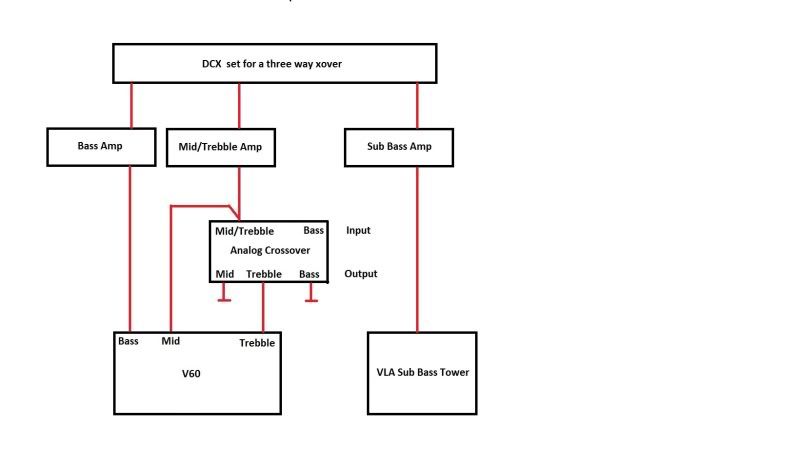It was suggested that the drawing from my post in the main section of this forum be added to this one here since it shows what Brian is describing and it will remain 'Stickied'. I think that was a good idea John. To help with the explanation I thought it best to include the entire post and not just the drawing.
There have been several people interested in going digitally active with the Behringer DCX 2496 for their speaker systems and I thought this post might help as a guide. I have the RM-V60s with flanking VLA bass towers. My system was originally set up for passive multi-amping using the included external analog xover. Once making that change over to the DCX I could never imagine life once again without it. I did have my concerns in the beginning though. I mean how could such a cheap non-audiophile industrial unit possibly sound reasonable, let alone vastly improve anything?
What sold me was Brian's enthusiasm for this unit. He did a lot of critical listening through it with the end results being that he found it extremely transparent when using the analog inputs. He mentioned that whatever ill effects there may be they were greatly outweighed by all the positives that unit could provide. There were discussions on this forum at the time about this, because how could it sound better for a digital source to be converted to analog first and then back to digital through the DCX, just to be converted back to analog once again for the output? Wouldn't it be better to keep the signal digital going in to the DCX and just have one conversion to analog for it's output? That does seem technically more logical. But, as with many things audio, listening tells us the true story and is the only one that has any real merit.
Personally I go analog in as well and do not like the digital in, even though my unit has been highly modified with that digital section improved over the stock version. Over the years just about everyone I talk to about this also uses the analog in. There must be something very synergistic with this unit where the ADC and the DAC are able to work seamlessly together, but when that internal chain is broken by going digital in that synergistic magic is not allowed to happen. Roger Sanders of Sanders Sound uses a stock DCX for the active crossover in his highly reviewed and highly resolving electrostats. He uses them analog in and never considered modifying them. He told me that was a good way to screw them up.
Brian wrote up a good tutorial on how to install the DCX:
http://www.audiocircle.com/index.php?PHPSESSID=8lt07tak95uq2k0ue69j05mae4&topic=63025.0 This was written early on during what I would still call the discovery phase of all this unit was capable of doing. In this tutorial he mentions using the set up of LH LH LH for the six output channels. I don't do this. My unit is set for LL MM HH which is a full three way design. All this designates is that there are three stereo pairs being output from the DCX. With the DCX you can make any pair anything you want and don't need to be concerned with the letter designations of low, midrange and high. Since my unit is modified allowing full analog volume control of two of those three pairs (LL and HH only), I am using LL for the output to my V60 mid bass and HH for the mids and highs. MM for me is the sub bass output to the VLAs. My sub bass amps have volume controls of their own.
Here is a basic block drawing of how both the digital DCX and outboard analog crossovers are being used in my system. Many ask if they can triamp a three-way speaker that does not use a separate subwoofer directly with the DCX, bypassing either an outboard analog crossover or a filter of some sort on the tweeter? Technically I see no reason why not, but I know that Brian did not recommend doing that and instead recommended using the DCX as a two-way xover in that circumstance. I know of several people that ended up blowing their tweeters even though they were being careful while triamping. It may be that the DCX is not a good buffer for amp start-up for such a sensative component?
